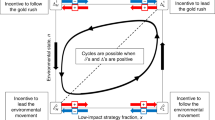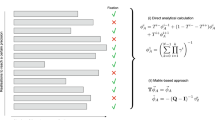Abstract
Evolutionary game theory1,2 is concerned with the evolutionarily stable outcomes of the process of natural selection. The theory is especially relevant when the fitness of an organism depends on the behaviour of other members of its population. Here we focus on the interaction between two organisms that have a conflict of interest. The standard approach to such two-player games is to assume that each player chooses a single action and that the evolutionarily stable action of each player is the best given the action of its opponent. We argue that, instead, most two-player games should be modelled as involving a series of interactions in which opponents negotiate the final outcome. Thus we should be concerned with evolutionarily stable negotiation rules rather than evolutionarily stable actions. The evolutionarily stable negotiation rule of each player is the best rule given the rule of its opponent. As we show, the action chosen as a result of the negotiation is not the best action given the action of the opponent. This conclusion necessitates a fundamental change in the way that evolutionary games are modelled.
This is a preview of subscription content, access via your institution
Access options
Subscribe to this journal
Receive 51 print issues and online access
$199.00 per year
only $3.90 per issue
Buy this article
- Purchase on Springer Link
- Instant access to full article PDF
Prices may be subject to local taxes which are calculated during checkout


Similar content being viewed by others
References
Maynard Smith,J. Evolution and the Theory of Games (Cambridge Univ. Press, Cambridge, 1982).
Parker,G. A. & Maynard Smith,J. Optimality theory in evolutionary biology. Nature 348, 27–33 (1990).
Pulliam,H. R., Pyke,G. H. & Caraco,T. The scanning behaviour of juncos: a game-theoretical approach. J. Theor. Biol. 95, 89–103 (1982).
Lima,S. L. Vigilance while feeding and its relation to the risk of predation. J. Theor. Biol. 124, 303–316 (1987).
McNamara,J. M. & Houston,A. I. Evolutionarily stable levels of vigilance as a function of group size. Anim. Behav. 43, 641–658 (1992).
Wright,J. & Cuthill,I. C. Biparental care: short-term manipulation of partner contribution and brood size in the starling, Sturmus vulgaris. Behav. Ecol. 1, 116–124 (1990).
Markman,S., YomTov,Y. & Wright,J. Male parental care in the orange-tufted sunbird—behavioural adjustments in provisioning and nest guarding effort. Anim. Behav. 50, 655–669 (1995).
Houston,A. I. & Davies,N. B. in Behavioural Ecology: The Ecological Consequences of Adaptive Behaviour (eds Sibly, R. M. & Smith, R. H.) 471–487 (Blackwell Scientific, Oxford, 1985).
Hatchwell,B. J. & Davies,N. B. Provisioning of nestlings by dunnocks, Prunella modularis, in pairs and trios: compensation reactions by males and females. Behav. Ecol. Sociobiol. 27, 199–209 (1990).
Clutton-Brock,T. H. & Godfray,H. C. J. in Behavioural Ecology (eds Krebs, J. R. & Davies, N. B.) 234–262 (Blackwell Scientific, Oxford, 1991).
Mock, D W. & Parker,G. A. The Evolution of Sibling Rivalry (Oxford Univ. Press, Oxford, 1997).
Dugatkin,L. A. Cooperation Among Animals (Oxford Univ. Press, Oxford, 1997).
Parker,G. A. & Milinski,M. Cooperation under predation risk: a data-based ESS analysis. Proc. R. Soc. Lond. B 264, 1239–1247 (1997).
Grafen,A. Biological signals as handicaps. J. Theor. Biol. 144, 517–546 (1990).
Maynard Smith,J. Honest signalling: the Philip Sidney game. Anim. Behav. 42, 1034–1035 (1991).
Johnstone,R. A. Honest signalling, perceptual error and the evolution of ‘all-or-nothing’ displays. Proc. R. Soc. Lond. B 256, 169–175 (1994).
Godfray,H. C. J. Signalling of need by offspring to their parents. Nature 352, 328–330 (1995).
Acknowledgements
We thank I. Cuthill, S. Hunt, J. Hutchinson, I. Jewitt, P. Sozou and M. Yallop for comments on previous versions of this manuscript.
Author information
Authors and Affiliations
Corresponding author
Rights and permissions
About this article
Cite this article
McNamara, J., Gasson, C. & Houston, A. Incorporating rules for responding into evolutionary games. Nature 401, 368–371 (1999). https://doi.org/10.1038/43869
Received:
Accepted:
Issue Date:
DOI: https://doi.org/10.1038/43869
This article is cited by
-
Female and male body condition in the Whiskered Tern Chlidonias hybrida, a species with female offspring desertion: a test of the differential parental capacity hypothesis
Journal of Ornithology (2024)
-
Sex differences in avian parental care patterns vary across the breeding cycle
Nature Communications (2023)
-
Emergence of games from ecological trade-offs: longevity changes strategies for extra-pair mating in birds
Behavioral Ecology and Sociobiology (2023)
-
Experimental variation of perceived predation risk does not affect coordination of parental care in long-tailed tits
Behavioral Ecology and Sociobiology (2023)
-
Nest-relief behaviors and usage of call types in the Kentish plover (Charadrius alexandrinus)
Journal of Ethology (2023)
Comments
By submitting a comment you agree to abide by our Terms and Community Guidelines. If you find something abusive or that does not comply with our terms or guidelines please flag it as inappropriate.



